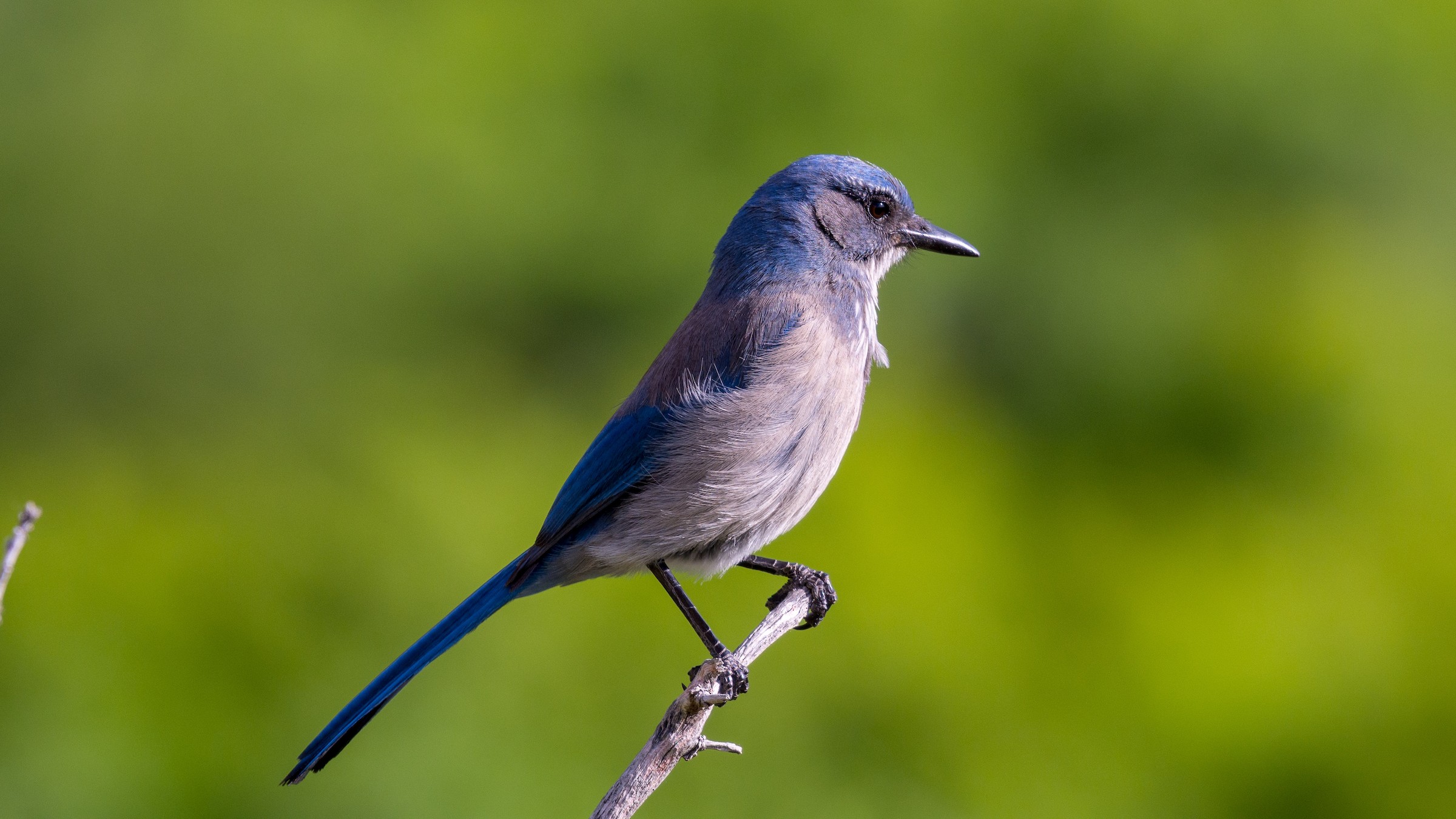
In the opulent tapestry of the natural world, few creatures command attention quite like the Jay. These members of the Corvidae family, which also includes crows, ravens, and magpies, are often lauded as among the most intelligent species in the avian kingdom. With their vibrant plumages, distinct vocalizations, and often boisterous personalities, Jays bring a unique blend of artistry and intellect to the landscapes they inhabit.
Indeed, the world of Jays is a collection of living masterpieces, each species an intricate design in its own right. From the striking azure of a Blue Jay to the subtle grays of a Canada Jay, their forms and behaviors are a testament to nature’s boundless creativity. They are, in essence, the feathered connoisseurs of the forest, known for their elaborate food caching strategies, their keen observational skills, and their complex social dynamics.
While there are about 30 to 45 species of jays globally, our curated exploration focuses on the magnificent dozen that grace the North American continent. These birds, often categorized simply into Old World, New World, and Grey Jays, offer a compelling study in adaptation and regional beauty. Join us as we unveil the first six of these captivating North American Jays, appreciating the individual artistry and lifestyle of each.
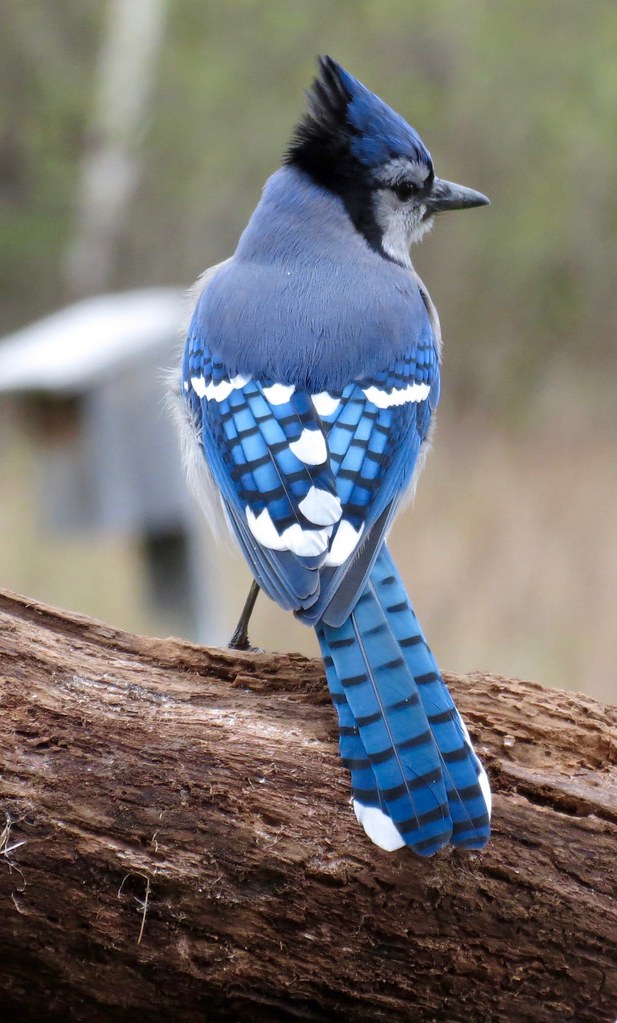
1. **Blue Jay**
Unquestionably one of the most recognizable birds across the Midwest and East, the Blue Jay (Cyanocitta cristata) is a vision in vivid blue, marked by a striking upright crest, blue and black backs, and immaculate white undersides. Its presence is often announced by a distinctive, loud “jayyy jayyy” call that resonates through deciduous and coniferous woodlands alike. These large songbirds are hard to miss, and their white wing-bars only add to their visual grandeur.
Blue Jays are year-round residents in the eastern US states and Southern Canada, though some may journey west for winter, albeit infrequently. They thrive in various environments, from dense forests, especially near oak trees from which they source their beloved acorns, to suburban backyards. Their adaptability is a hallmark of their sophisticated lifestyle, allowing them to integrate into human-altered landscapes with ease.
Their diet is as varied as their habitat, encompassing insects, nuts, seeds, and grain. Notably, they have a particular fondness for acorns, peanuts, and beechnuts. Beyond plant matter, Blue Jays are known to be opportunistic feeders, occasionally taking eggs from nests or even nestlings, a reminder of the wilder aspects of their elegant existence. This broad diet underscores their resourcefulness in securing sustenance throughout the seasons.
Blue Jays communicate through a rich repertoire of sounds, ranging from harsh clicks, peeps, and ‘caws’ to melodic whistles during courtship. Their social nature is evident as they travel in family groups, often being perceived as ‘bullies’ by some due to their assertive presence at feeders. Interestingly, these intelligent birds have a playful side, known to interact with shiny objects like aluminum or bottle caps, carrying them around, dropping them, and picking them up—a fascinating glimpse into their cognitive curiosity. To attract them, platform or tray feeders stocked with peanuts, sunflower seeds, and suet are highly recommended, alongside a refreshing birdbath.
Read more about: The A-List Tightrope: 9 Actors Who Show How Easily Your Big Break Can Slip Away
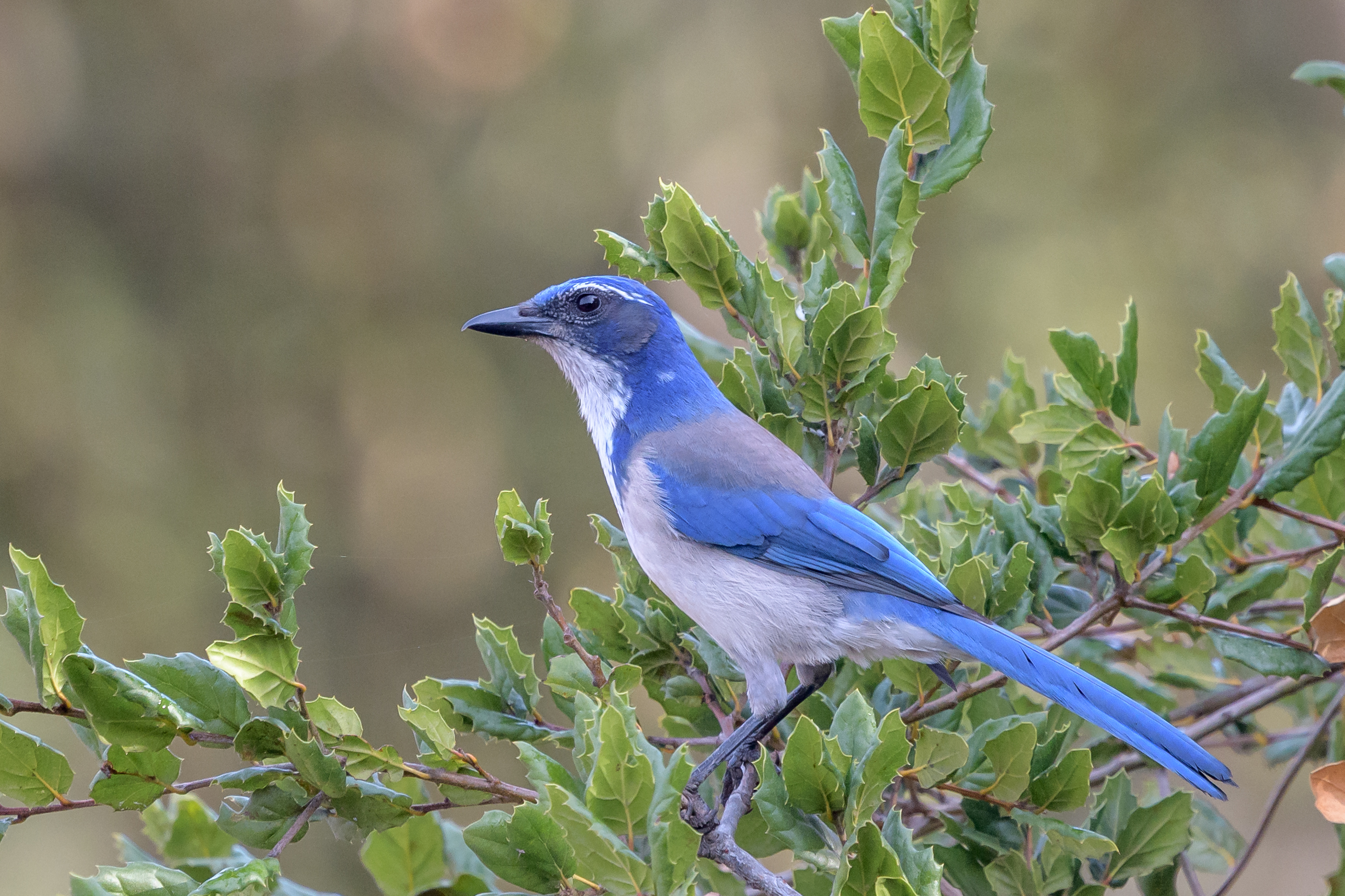
2. **California Scrub-Jay**
The California Scrub-Jay (Aphelocoma californica) presents a distinct aesthetic with its rich blue and gray back contrasting against whitish undersides, accented by a bright blue breast band. These large songbirds, larger than a robin but smaller than a crow, possess long tails and, unlike some of their crested cousins, are crestless. They share a visual similarity with the Woodhouse’s Scrub-Jay, though the California species exhibits more vivid colors.
These jays are resident year-round along the Pacific Coast, extending from British Columbia down to Baja California. They are frequently observed in scrub, oak woodlands, and even integrated into suburban yards and parks. This remarkable adaptability allows them to flourish in both wild and developed settings, making them a common and welcome sight for many.
Omnivorous by nature, their diet shifts with the seasons. In spring and summer, they primarily consume insects and fruit, transitioning to seeds and nuts, especially acorns, during fall and winter. A particularly fascinating habit is their diligent caching of acorns for later consumption, showcasing their foresight and planning. This meticulous storage ensures their survival through leaner times, a testament to their intelligence.
California Scrub-Jays are known for their high-pitched, repetitive calls, though they also engage in soft, musical courtship songs when with their mate. Their nesting habits are equally intriguing; nests are cup-shaped, constructed from twigs and soft lining, often hidden within oak trees by both parents. A unique and poignant behavior noted by the University of California – Davis is their tendency to gather and “screech over the body of a dead jay and invite others to do the same, and this can last up to half an hour,” highlighting a complex social and emotional dimension. To entice these birds to one’s garden, sunflower seeds and peanuts are effective offerings.
Read more about: The 12 Ultimate Jay Species: Nature’s Bespoke Avians Defining Elite Style and Intelligence

3. **Steller’s Jay**
Dominating the evergreen forests of the mountainous West, the Steller’s Jay (Cyanocitta stelleri) is an unmistakable presence with its striking black triangular crest rising prominently from its head. The deep black extends over their head, chest, and back, culminating in a vibrant blue for the rest of their body. They possess small white or blue spots on their forehead, adding a touch of subtle detail to their bold appearance.
These majestic jays are permanent residents in the western US states, western Canada, Mexico, and Central America. While they typically prefer exploring the higher canopies of their forest homes, they are not shy about descending into backyards or frequenting picnic tables and campgrounds, revealing their inquisitive nature and readiness to interact with human environments. Their adaptability allows them to thrive in diverse mountainous and forested landscapes.
Steller’s Jays are omnivores, foraging for a wide array of food items including insects, seeds, nuts, berries, eggs, and nestlings. Their opportunistic feeding habits extend to becoming quite the “nuisance around garbage and your unguarded picnic,” as the context aptly puts it, a testament to their cleverness in exploiting available food sources. This varied diet underpins their success in their rugged habitats.
Their vocalizations are as diverse as their diet, comprising harsh ‘kaw’ sounds, rapid two-toned calls, peeps, and guttural expressions. Adding to their allure, Steller’s Jays are excellent mimics, capable of imitating other bird species, and even mechanical sounds like sprinklers and alarms. Nests are meticulously constructed near the tops of conifer trees, fashioned from leaves and plant material held together with mud, then lined with soft pine needles. Attracting these bold and intelligent birds to your backyard can be achieved by offering peanuts and suet, providing a chance to observe their fascinating behaviors firsthand.
Read more about: The 12 Ultimate Jay Species: Nature’s Bespoke Avians Defining Elite Style and Intelligence
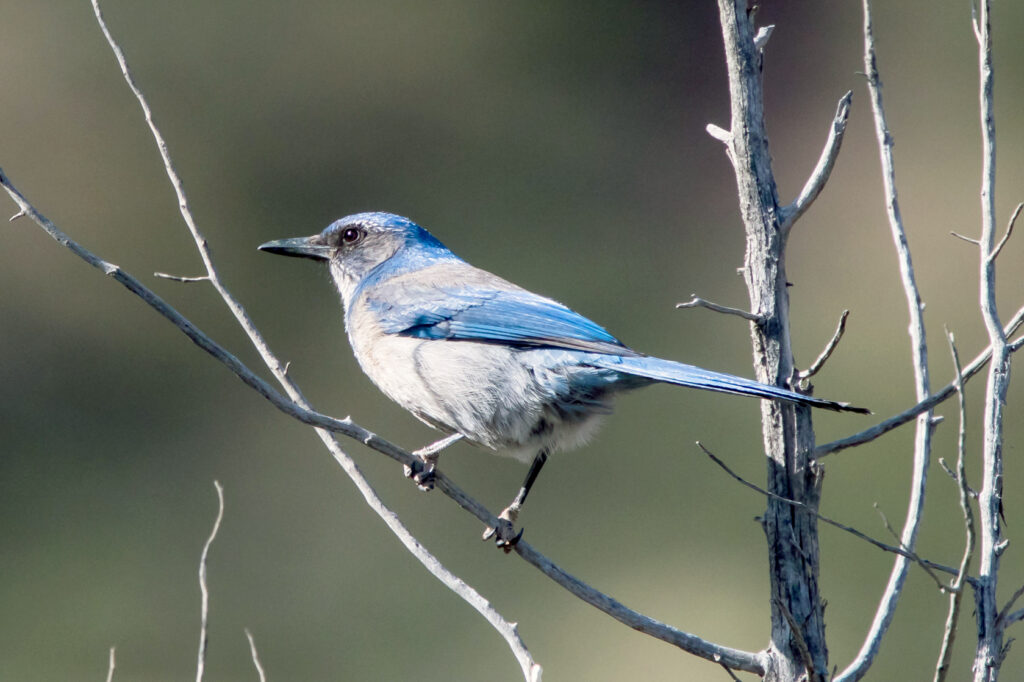
4. **Woodhouse’s Scrub-Jay**
The Woodhouse’s Scrub-Jay (Aphelocoma woodhouseii) gracefully carries the mantle of the “Blue-Jays of the Southwest,” adorned in lovely blue and gray hues. Their backs are a light blue and dark gray, transitioning to a soft light gray underneath. A notable feature is their long blue tail, while their appearance is generally duller in color compared to their California Scrub-Jay relatives, with only a small necklace and, like their scrub-jay kin, lacking the prominent crests found on Blue Jays and Steller’s Jays.
These jays are year-round inhabitants inland across the southwest US states and Mexico. They thrive in wooded areas characterized by pinyon-juniper forests and scrubby landscapes. Their preference for these specific habitats underscores their intimate connection with the unique flora of the arid and semi-arid regions they call home, blending seamlessly into the tapestry of the high desert and mountain ecosystems.
Their diet follows a seasonal rhythm, primarily consisting of insects and fruit during the warmer summer months. As winter approaches, their menu shifts to nuts and seeds, reflecting their adaptive foraging strategies. This ability to vary their diet ensures their sustenance throughout the changing seasons, a vital trait for survival in their often challenging environments.
Nesting for the Woodhouse’s Scrub-Jay involves fairly simple platforms constructed from twigs and lined with moss and grass, offering a cozy haven for their young. A particularly intriguing aspect of their behavior, as noted in the context, is their reputation as “thieves that steal food from other birds stores, especially Acorn Woodpeckers’ granary tree store of acorns.” This audacious kleptoparasitism highlights their ingenuity and resourcefulness in securing food, even if it means outsmarting their neighbors. For those wishing to welcome these blue-and-gray beauties, sunflower seeds and peanuts are excellent choices for backyard feeders.
Read more about: The 12 Ultimate Jay Species: Nature’s Bespoke Avians Defining Elite Style and Intelligence
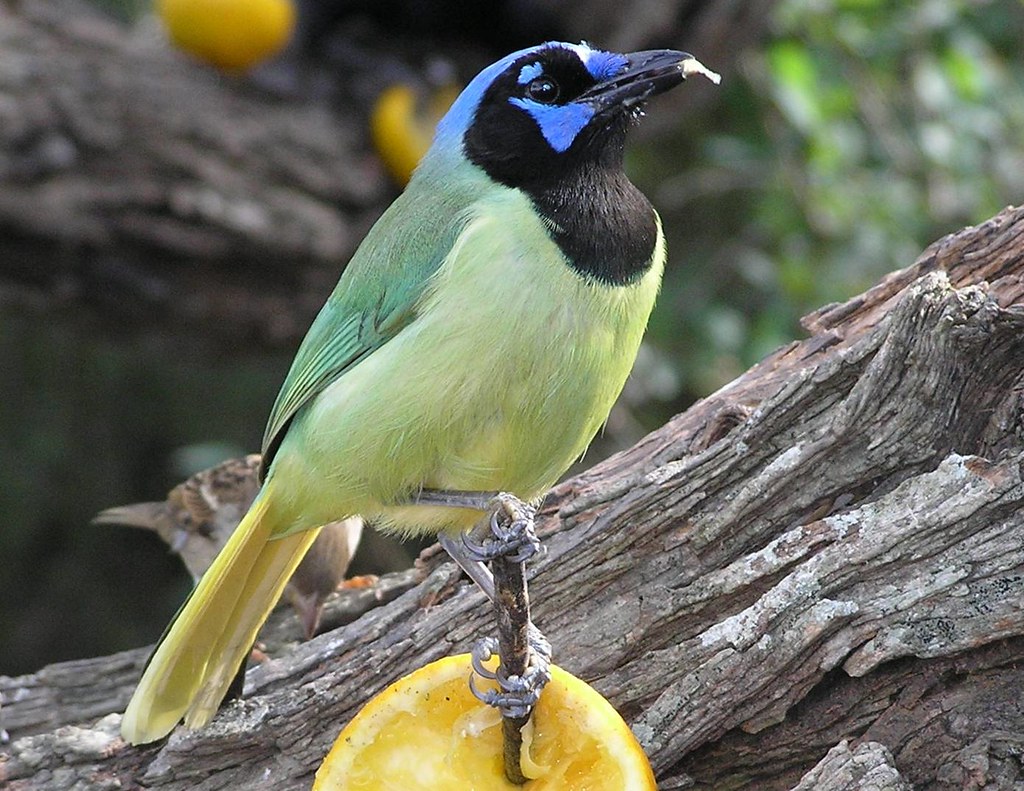
5. **Green Jay**
Prepare to be captivated by the Green Jay (Cyanocorax yncas), a spectacular avian marvel that offers a fantastic mix of bright green, blue, and black. Their backs are a dark green, which fades into paler bellies, while their heads are adorned with striking bright blue and black markings. This vibrant coloration makes them one of the most visually stunning members of the Jay family, a living jewel amidst the foliage.
This colorful species is a rare and coveted find within the United States, primarily seen only in southern Texas. Beyond the US border, their usual range extends along the coasts of Mexico, Central America, and South America, hinting at their tropical origins. Their presence in Texan wildlife refuges is a testament to the northward expansion of their range, offering bird enthusiasts a chance to witness their exotic beauty.
Green Jays prefer woodlands, particularly those near streams and other water sources, where the lush environment provides ample foraging opportunities. Their diet consists of insects, fruit, and seeds, showcasing their omnivorous tendencies. Those fortunate enough to encounter them at Texan bird feeders might observe their fondness for unexpected delights such as oranges and grape jelly, in addition to peanuts, sunflower seeds, and corn.
Their vocal repertoire is diverse, featuring a variety of fast calls that can be ‘Kaw’-like, buzzing, clicking, peeps, and even screams. Nests are typically simple twig constructions, lined with moss, leaves, and grass, providing a secure place for their clutch. Remarkably, even their eggs possess a greenish tint, echoing their own vibrant plumage. A fun fact highlights their intelligence: “Green Jays are one of a few birds that can use tools, and they will use sticks to help pry up bark to get to food below,” demonstrating an advanced problem-solving capability rare in the avian world.
Read more about: Your Ultimate NYC Foodie Bucket List: 14 Must-Visit Restaurants That Are Absolutely Slaying the Culinary Scene!
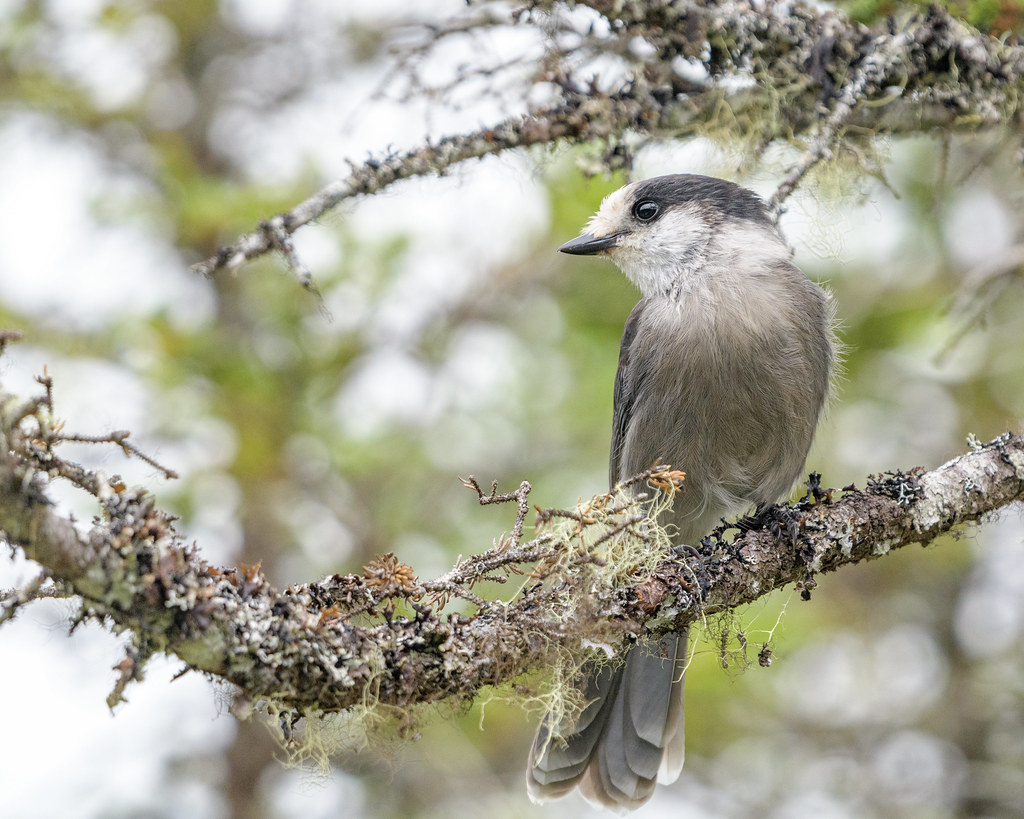
6. **Canada Jay**
Endearingly tame and undeniably cute, the Canada Jay (Perisoreus canadensis), formerly known as the Gray Jay, presents a distinct departure from the more boisterous demeanor of its kin. These birds are characterized by a dark gray back, soft pale gray undersides, and white heads and throats, beautifully framed by a black band running around the back of the head. Females are visually identical to males, while juveniles sport a darker gray plumage overall, offering a subtle variation in their charm.
Canada Jays are resident across Canada, Alaska, and the elevated mountains of the northwest US, adapting to some of the harshest environments. Regional color differences are noted, with individuals in the Rockies often appearing paler than their Canadian counterparts. They are intimately tied to boreal forests, particularly where spruce trees are common, showcasing their deep integration with these northern ecosystems.
While not as loud as other Jays, they are renowned as “opportunity feeders,” readily consuming a wide variety of food including insects, berries, and carrion. Their tameness is legendary; they are famous for approaching hikers, hunters, and campers, often eating directly from a human hand. Despite their sweet appearance, the context reveals a “deadly side,” as they “will kill baby birds for food and even hunt smaller species such as chickadees and warblers,” a stark reminder of the realities of survival in the wild. Their primary goal is meat, bread, suet, and other soft foods, which they meticulously cache.
Their vocalizations include a gentle whispered song, contrasted by harsher calls and clatters, and they are adept at imitating other species. A fascinating adaptation for their winter survival strategy is their production of “special saliva, which they use to mold food into a sticky blob, and then they stick it in a hiding place like gum under a desk.” Nests are built remarkably early in conifers, often while snow still blankets the ground, typically on the south side of a tree for warmth, and are lined with feathers. Attracting these calm yet cunning birds to a backyard is straightforward with most bird foods, seeds, and suet, readily accepted from tube or platform feeders.
Continuing our journey through the feathered connoisseurs of North America, we now turn our gaze to six more fascinating Jay species. Each one, a testament to nature’s intricate design, offers further insights into the rich tapestry of avian adaptation and regional beauty. From the pinyon-studded landscapes to the sun-kissed scrublands, these birds exhibit a stunning array of behaviors, calls, and special adaptations that allow them to flourish in their unique environments.
Read more about: Unleash Your Inner Tuner: The 13 Best Affordable Cars Under $25,000 to Customize in 2025

7. **Pinyon Jay**
The Pinyon Jay (Gymnorhinus cyanocephalus) presents a mesmerizing spectacle in shades of blue, a visual symphony that echoes the vast western skies. With darker backs and paler bellies, these jays are a uniform blue across their entire form, distinguishing them from their more piebald relatives. Notably, they possess white throats and shorter tails, and unlike the crested grandeur of species such as the Steller’s Jay, they remain uncrested, embodying a sleek elegance in their silhouette. Juvenile Pinyon Jays, with their slightly more grayish-blue plumage, offer a subtle variation on this sophisticated palette.
These captivating jays are permanent residents of the inland western US states, establishing their homes predominantly within the iconic pinyon-pine forests. Their very existence is deeply intertwined with these particular arboreal ecosystems, a relationship that defines much of their lifestyle. The Pinyon Jay’s preference for this specific habitat underscores its intimate connection to the unique flora of the semi-arid regions it inhabits, showcasing a specialized adaptation to its chosen domain.
Their diet, a reflection of their habitat, centers around the rich bounty of pinyon-pine seeds. Beyond this primary sustenance, Pinyon Jays also forage for juniper berries, acorns, and a variety of animal proteins, including lizards, baby birds, and insects. These opportunistic feeders are known for their boisterous nature, often gathering in large, noisy groups to seek out sustenance, a collective endeavor that highlights their social intelligence and collaborative spirit in the pursuit of food.
The vocalizations of the Pinyon Jay are a distinctive aspect of their communication, characterized by three ‘kaw’-like calls delivered in close succession. These calls ascend and then descend in pitch, sometimes exhibiting a shaking or trembling quality, adding an ethereal dimension to their forest pronouncements. Their nests, meticulously crafted from sticks and grass within the branches of pine trees, are then softly lined with feathers and animal hair, creating a secure and comfortable sanctuary for their developing offspring. A particularly remarkable adaptation of this species is the absence of feathers over their nostrils, a clever evolutionary design preventing the sticky pine pitch from adhering to and fouling their plumage, a testament to their remarkable integration with their environment.
Read more about: The 12 Ultimate Jay Species: Nature’s Bespoke Avians Defining Elite Style and Intelligence

8. **Florida Scrub-Jay**
The Florida Scrub-Jay (Aphelocoma coerulescens) is a true blue gem, with its striking blue plumage offset by soft gray bellies, backs, and foreheads. These birds feature elegant long blue tails and, akin to some of their scrub-jay relatives, gracefully lack the prominent crests found on other jay species. While both males and females share this captivating appearance, the juveniles present a slightly grayer overall hue and head coloration, reflecting the subtle shifts in their developing beauty.
As their evocative name suggests, the Florida Scrub-Jay is an exclusive inhabitant of Florida, demonstrating an extraordinary fidelity to its native land. These jays are endemic to the state, meaning they are found nowhere else in the world, a unique distinction that underscores their vulnerability. They do not undertake migrations, cementing their status as steadfast residents of Florida’s distinctive landscapes, where they have perfected the art of living within their specialized environment.
One can discover the Florida Scrub-Jay within relatively open, sandy scrubby areas, particularly those rich in oak scrub. Here, they are frequently observed foraging on the ground, meticulously searching for insects and berries, and displaying a particular fondness for acorns. Sadly, this exquisite species is currently listed as vulnerable on the IUCN Red List, a somber reminder of the delicate balance of their existence and the pressures facing their specialized habitats.
Their vocal repertoire is characterized by quite harsh calls, with these jays spending a considerable amount of time engaging in lively communication with one another. Florida Scrub-Jays are renowned for forming cooperative flocks, which often include young birds from previous years. These communal groups play a crucial role in safeguarding against predators and collectively nurturing their young, a sophisticated social structure that enhances their survival. A fascinating behavioral insight reveals their method for opening acorns: they skillfully hold the nuts in their feet and use their bills to hammer them open, a testament to their intelligent foraging techniques.
Read more about: The 12 Ultimate Jay Species: Nature’s Bespoke Avians Defining Elite Style and Intelligence

9. **Black-throated Magpie-Jay**
The Black-throated Magpie-Jay (Calocitta colliei) makes an undeniably striking visual statement, a grand symphony of contrasts. This large, long-tailed bird is instantly recognizable by its conspicuous black crest and a throat of the same deep hue. A vivid patch of blue adorns its eyebrows and area beneath the eye, complementing its blue wings, while a pristine white-tipped tail and a crisp white underside complete its majestic presentation. Intruigingly, in the southern reaches of their geographical range, these jays exhibit a more delicate white throat with only a slender black band, showcasing regional variations in their exquisite design.
These magnificent jays prefer the lush tapestry of tropical lowland forests, flourishing also within plantations and partially open areas punctuated by tall trees and verdant hedges. They demonstrate a particular discerning taste, however, for they are not especially fond of overly humid woodlands, indicating a preference for specific climatic conditions that align with their sophisticated lifestyle. Their chosen habitats are a testament to their adaptable nature, allowing them to thrive across diverse arboreal environments.
True to the omnivorous nature characteristic of the Corvidae family, the Black-throated Magpie-Jay partakes in a varied diet, encompassing both plant and animal matter. While they harbor a clear affection for seeds and nuts, their foraging extends to include insects and even smaller birds, showcasing their opportunistic culinary preferences. Their nesting habits are equally meticulous; a nest is typically crafted from sticks and twigs, carefully lined with soft materials, designed to cradle up to seven precious eggs, reflecting their dedicated approach to raising their young.
A particularly engaging “fun fact” illuminates their unique dining etiquette: the Black-throated Magpie-Jay exhibits an almost human-like posture while eating, standing upright as it meticulously consumes its meal. One foot is skillfully employed to secure the food, while the other gracefully delivers sustenance to its mouth, a charming display of dexterity and sophisticated foraging behavior that sets them apart within the avian world.
Read more about: The 12 Ultimate Jay Species: Nature’s Bespoke Avians Defining Elite Style and Intelligence
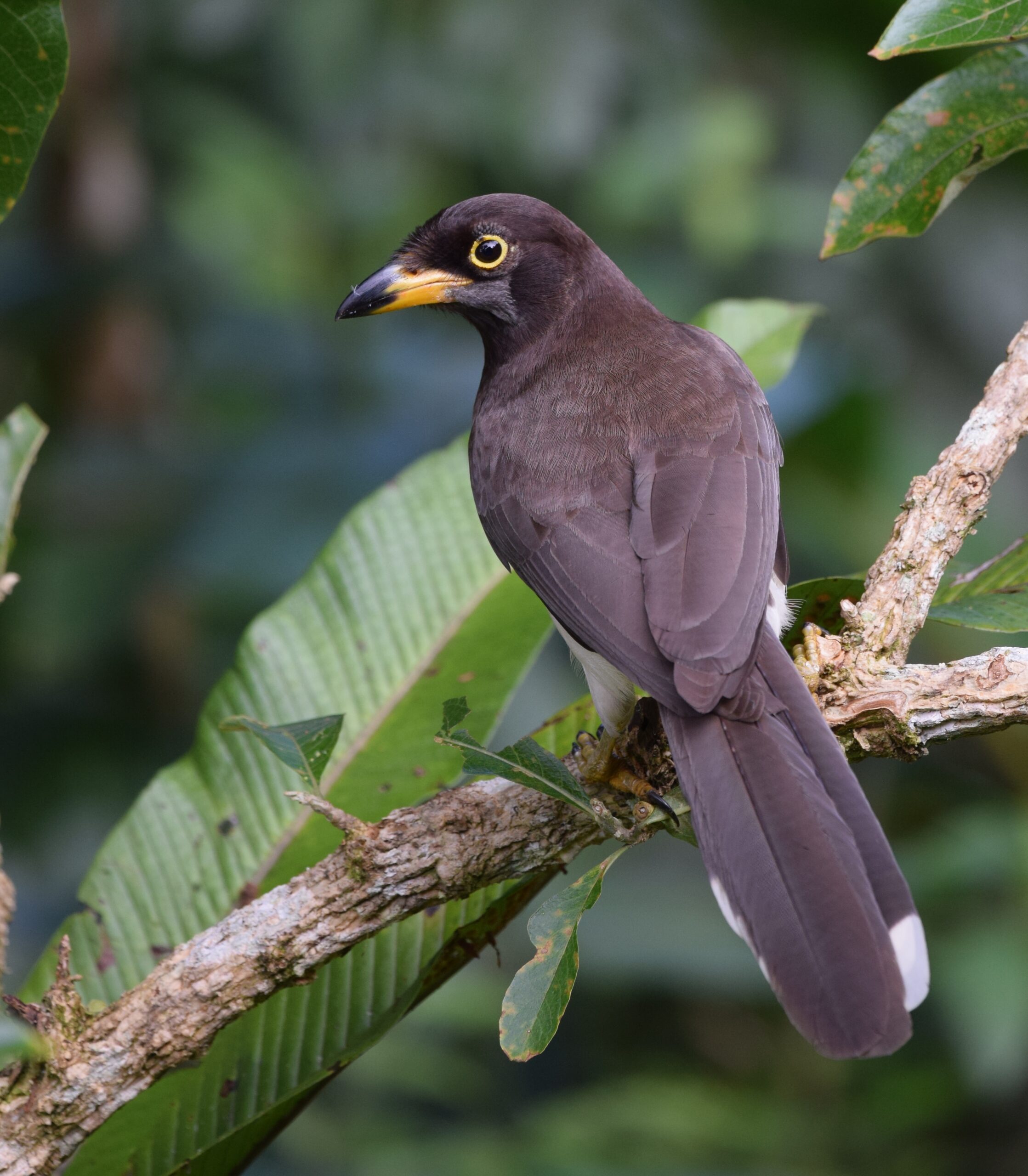
10. **Brown Jay**
The Brown Jay (Psilorhinus morio) commands attention with its substantial size and a plumage that, while often uniformly dark brown, can exhibit subtle regional variations. Some southern populations present a lighter tint on their backs, or even a crisp white belly and distinct white tips to their tail feathers, adding a nuanced beauty to their appearance. A discerning eye will note the striking differences between generations: adults are characterized by their sleek black bills, legs, and feet, while the young birds sport bright yellow legs and an equally vibrant yellow eyering, a fascinating visual marker of their growth and development.
Primarily gracing the landscapes of Mexico and Central America, the Brown Jay extends its northern reach into southern Texas, marking its presence as a rare but magnificent sight within the United States. Its appearance in these border regions offers a glimpse into its broader tropical origins. One can discover these impressive birds thriving in dense woodlands, particularly where tall trees provide ample cover and proximity to water sources, underscoring their preference for environments that offer both shelter and vital hydration.
The Brown Jay’s diet exemplifies its omnivorous nature, a sophisticated palate that embraces both the bounty of the plant kingdom and the sustenance of animal life. They meticulously forage for insects and small rodents, while also indulging in a rich variety of berries, fruits, seeds, and even nectar. Their feeding strategies are diverse; they can be observed finding food on the ground with a keen eye or gracefully hopping from branch to branch within the forest canopy, showcasing their adaptability in securing sustenance across different strata of their habitat.
A truly remarkable aspect of Brown Jay social life revolves around their communal nesting. Flocks of these intelligent birds share collective nests, strategically positioned within a forked branch of a tree or a low-lying shrub. Multiple adults collaborate in the intricate construction of these cup-shaped nests, weaving together sticks and twigs, then meticulously lining them with soft weeds and other delicate materials to create a cozy sanctuary for their eggs. They typically lay up to eight eggs, which hatch after approximately twenty days, with the young birds fledging in about four weeks, a testament to their cooperative breeding efforts. Indeed, the Brown Jay proudly holds the distinction of being the largest North American Jay, a title befitting its impressive stature and grand presence.
Read more about: Your Ultimate NYC Foodie Bucket List: 14 Must-Visit Restaurants That Are Absolutely Slaying the Culinary Scene!

11. **Mexican Scrub-Jay**
The Mexican Scrub-Jay (Aphelocoma wollweberi) presents a study in understated elegance, characterized by its medium size and a refined, pale bluish-gray plumage. This species boasts a lighter coloration compared to many of its jay cousins, accented by a subtle grayish upper neckline and chest that lends it a distinctive, almost ethereal quality. Its profile is further defined by a small, precisely formed black bill, adding a touch of delicate detail to its otherwise serene appearance.
These captivating jays are the treasured inhabitants of open oak and pine woods and forests, establishing their presence within the majestic arboreal landscapes of the southwestern United States and Mexico. Their preferred habitat, a harmonious blend of oak and pine, provides a rich environment for their complex social structures and foraging behaviors. The Mexican Scrub-Jay’s deep connection to these specific woodland ecosystems highlights their specialized adaptations to mountainous and forested terrains.
The diet of the Mexican Scrub-Jay is as varied as its habitat, primarily consisting of insects, small reptiles, and, rather remarkably, the eggs and young of other birds during the warmer months. As the seasons transition towards winter, their menu gracefully shifts to stored acorns and pine nuts, a testament to their foresight and meticulous caching strategies from the preceding season. This adaptive foraging ensures their survival through leaner times, showcasing their ingenuity in securing sustenance.
Nesting for the Mexican Scrub-Jay is a collaborative endeavor, with both males and females contributing to the construction of their arboreal abodes. These nests, skillfully woven from sticks and twigs and softly lined with rootlets and plant fibers, are strategically located within trees and carefully protected by thick foliage, ensuring a secure haven for their developing brood. They typically lay around five eggs, which hatch after approximately eighteen days, with the young leaving the nest after about twenty-five days. A fascinating behavioral note reveals that, even after fledging, the young may continue to be cared for by the flock for several additional weeks, highlighting the species’ strong communal bonds. A delightful fun fact tells us that Northern Flickers are often observed following Mexican Jays in flight during migration, ingeniously utilizing the Jays’ loud, shrill warning calls to alert themselves to potential predators, showcasing an intriguing interspecies reliance.
Read more about: The 12 Ultimate Jay Species: Nature’s Bespoke Avians Defining Elite Style and Intelligence
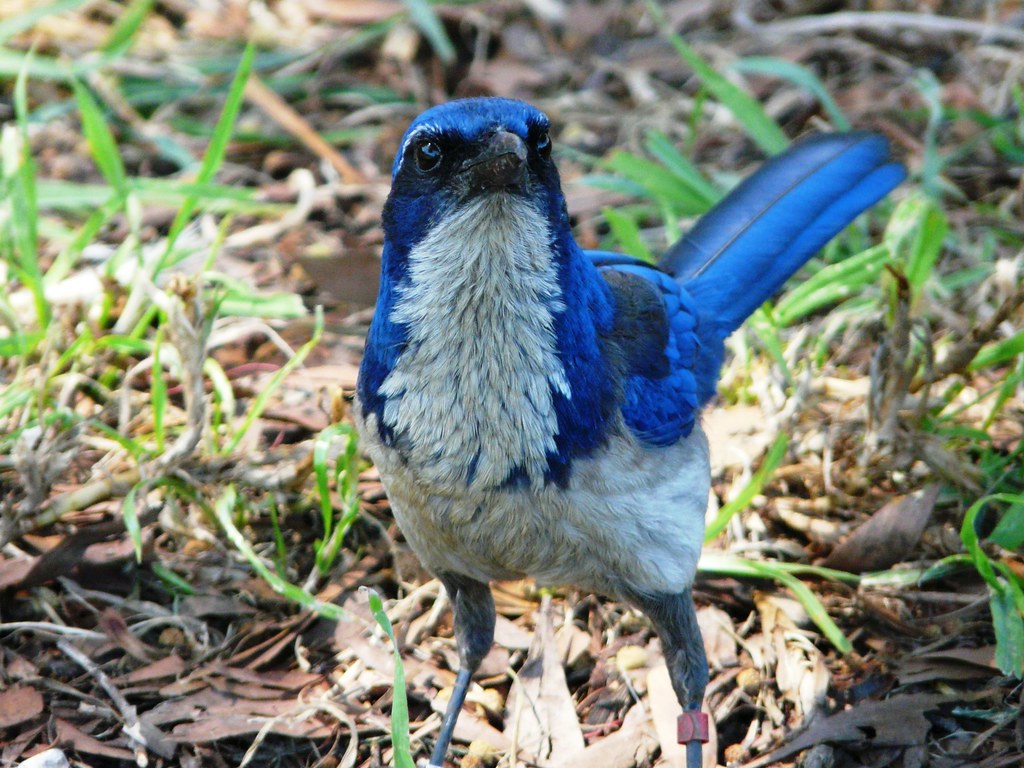
12. **Island Scrub Jay**
The Island Scrub-Jay (Aphelocoma insularis) stands as a particularly striking and brightly-colored avian marvel, sharing a visual kinship with the California Scrub-Jay but distinguished by its notably darker and more richly-hued feathers. A deep, vibrant blue cascades from its head to its tail along its back, complemented by a sophisticated gray atop its wings and a pristine white throat. This luxurious plumage is a testament to its unique evolutionary path, setting it apart with a profound visual statement.
These exquisite jays are steadfast, permanent residents of Santa Cruz Island, making them a truly singular presence in the avian world. Indeed, the Island Scrub-Jay is endemic to this specific locale, signifying that it is exclusively native to this Californian island and does not embark on migrations. The island itself is a verdant paradise, dominated by oak woodland and chaparral, punctuated by numerous streamside thickets and a diverse array of other trees, providing a specialized and bountiful habitat for this unique species.
The diet of the Island Scrub-Jay is a diverse and robust one, reflecting the rich resources of its island home. It primarily consists of insects, small lizards, mice, and, notably, the eggs and young of other smaller birds, demonstrating its role as an opportunistic predator within its ecosystem. As autumn arrives, this species indulges in a bountiful feast of acorns, skillfully employing its beak to meticulously break open the sturdy shells, a display of remarkable foraging prowess. Their nests, carefully concealed within the protective canopy of oak trees, are sturdily built with twigs and thoughtfully lined with soft rootlets and animal hair, ensuring a comfortable and secure sanctuary for their clutch of around four eggs. These eggs typically hatch after approximately eighteen days, though specific data on the exact timing of when the young birds leave the nest remains less documented.
A truly poignant “fun fact” underscores the unique nature of the Island Scrub-Jay: given that it never ventures beyond the confines of Santa Cruz Island, it holds the distinction of having the smallest geographical range of any North American bird. This remarkable exclusivity highlights both its specialized adaptation to its island home and its particular vulnerability to environmental changes, making it a precious and irreplaceable jewel of avian biodiversity.
Read more about: The 12 Ultimate Jay Species: Nature’s Bespoke Avians Defining Elite Style and Intelligence
Our journey through the world of North American Jays reveals a captivating collection of living masterpieces, each species an intricate design in its own right. From the Blue Jay’s iconic brilliance to the Island Scrub-Jay’s exclusive elegance, these birds are more than just feathered inhabitants; they are the vibrant connoisseurs of our natural landscapes. Their diverse plumages, complex behaviors, and sophisticated adaptations speak to nature’s boundless creativity and intelligence. As we conclude our exclusive look, we’re reminded of the profound beauty that exists just beyond our microphones, urging us to continue observing, appreciating, and protecting these extraordinary avian treasures, ensuring their vibrant artistry continues to grace our world for generations to come.


